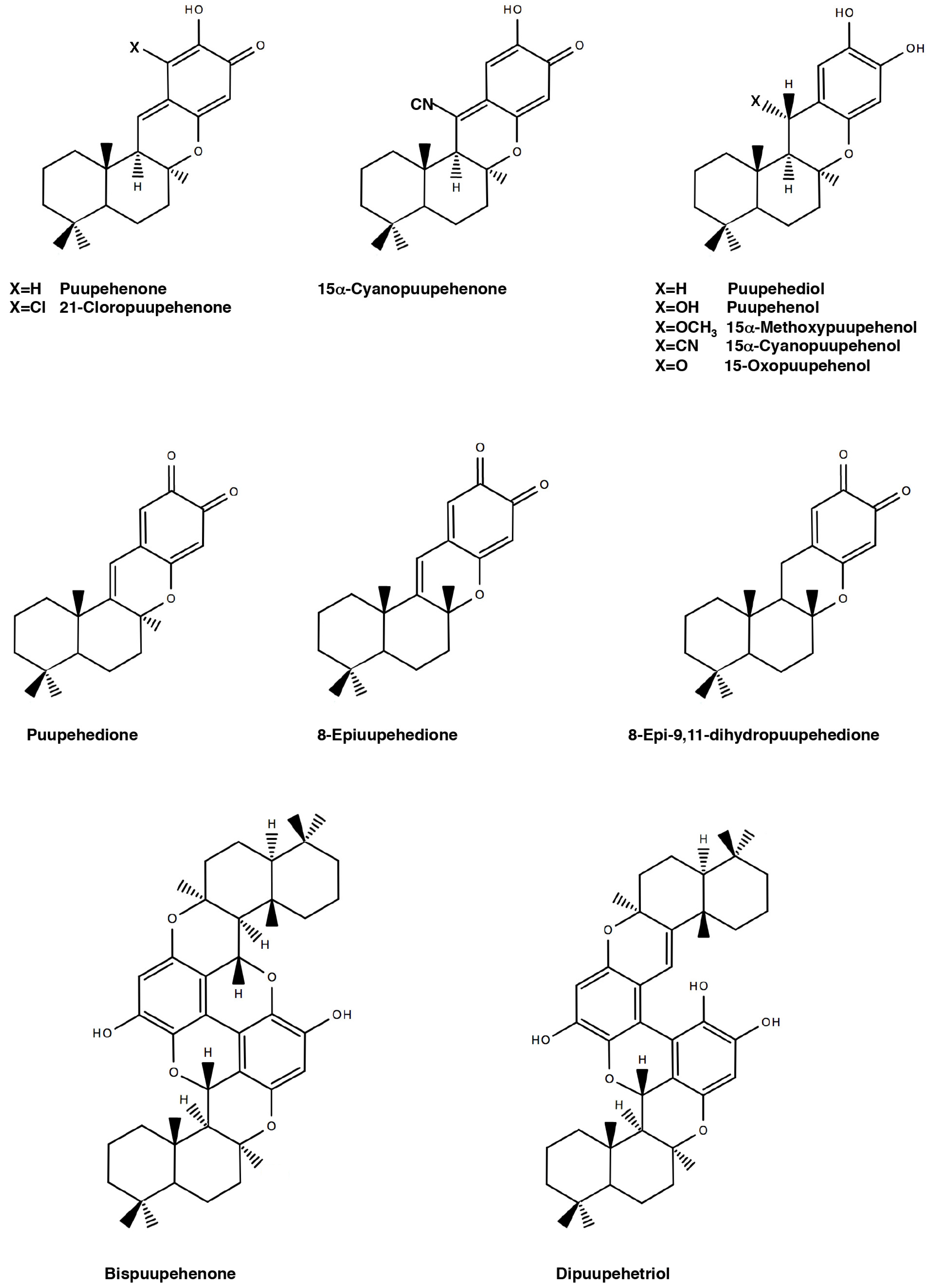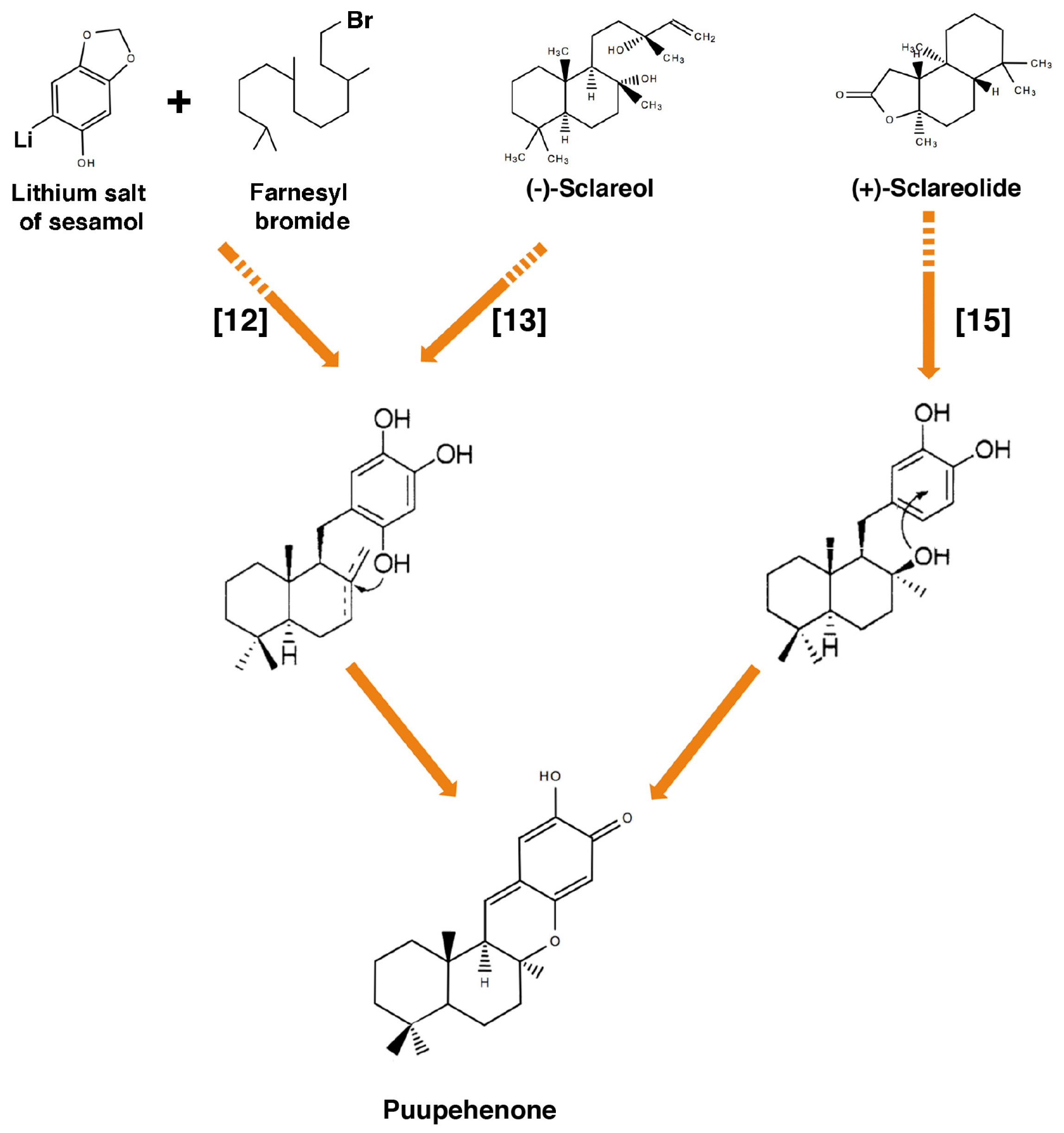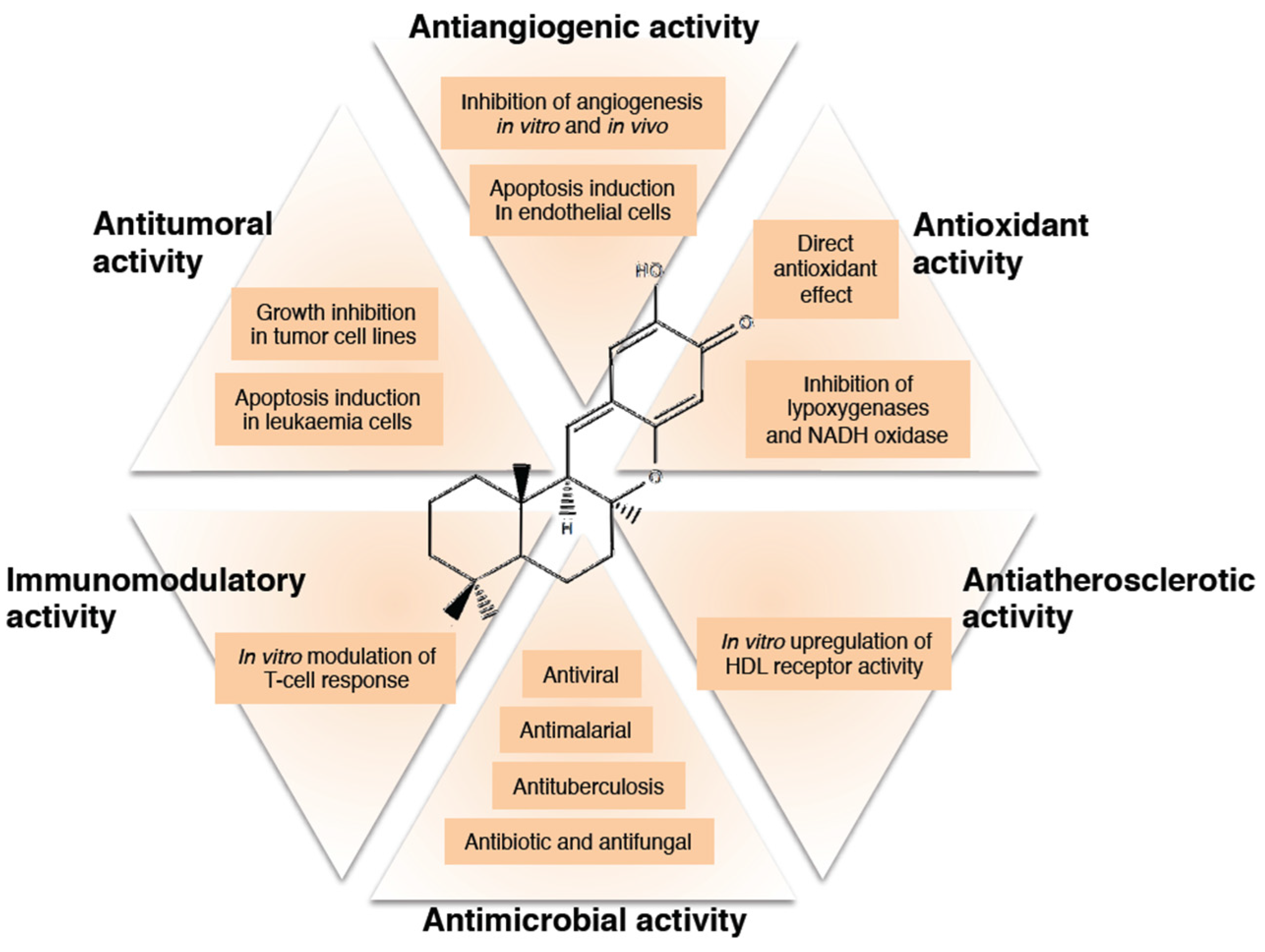Pleiotropic Role of Puupehenones in Biomedical Research
Abstract
:1. Origin and Biological Role of Puupehenones in Sponges
2. Diversity and Chemical Synthesis of Puupehenones
3. Biological Activities of Puupehenones
3.1. Antiangiogenic Activity
3.2. Antitumoral Effects of Puupehenones
3.3. Antioxidant Activity of Puupehenones
3.4. Antimicrobial Activities of Puupehenones
3.5. Immunomodulatory Activity of Puupehenones
3.6. Puupehenones and Atherosclerosis
4. Final Remarks and Future Challenges
Acknowledgments
Conflicts of Interest
References
- Anjum, K.; Abbas, S.Q.; Shah, S.A.A.; Akhter, N.; Batool, S.; Hassan, S.S.U. Marine Sponges as a Drug Treasure. Biomol. Ther. (Seoul) 2016, 24, 347–362. [Google Scholar] [CrossRef] [PubMed]
- Sipkema, D.; Franssen, M.C.R.; Osinga, R.; Tramper, J.; Wijffels, R.H. Marine sponges as pharmacy. Mar. Biotechnol. 2005, 7, 142–162. [Google Scholar] [CrossRef] [PubMed]
- Piña, I.C.; Sanders, M.L.; Crews, P. Puupehenone Congeners from an Indo-Pacific Hyrtios Sponge. J. Nat. Prod. 2003, 66, 2–6. [Google Scholar] [CrossRef] [PubMed]
- Ravi, B.N.; Perzanowski, H.P.; Ross, R.A.; Erdman, T.R.; Scheuer, P.J. Recent Research in Marine Natural Products: The Puupehenones. Pure Appl. Chem. 1979, 51, 1893–1900. [Google Scholar] [CrossRef]
- Urban, S.; Capon, R.J. Absolute Stereochemistry of Puupehenone and Related Metabolites. J. Nat. Prod. 1996, 59, 900–901. [Google Scholar] [CrossRef]
- Zjawiony, J.K.; Bartyzel, P.; Hamann, M.T. Chemistry of Puupehenone: 1,6-Conjugate Addition to Its Quinone-Methide System. J. Nat. Prod. 1998, 61, 1502–1508. [Google Scholar] [CrossRef] [PubMed]
- Hamann, M.T.; Scheuer, P.J.; Kelly-Borges, M. Biogenetically Diverse, Bioactive Constituents of a Sponge, Order Verongida: Bromotyramines and Sesquiterpene-Shikimate Derived Metabolites. J. Org. Chem. 1993, 58, 6565–6569. [Google Scholar] [CrossRef]
- Castro, M.E.; González-Iriarte, M.; Barrero, A.F.; Salvador-Tormo, N.; Muñoz-Chápuli, R.; Medina, M.Á.; Quesada, A.R. Study of puupehenone and related compounds as inhibitors of angiogenesis. Int. J. Cancer 2004, 110, 31–38. [Google Scholar] [CrossRef] [PubMed]
- Martínez-Poveda, B.; Quesada, A.R.; Medina, M.Á. The anti-angiogenic 8-epipuupehedione behaves as a potential anti-leukaemic compound against HL-60 cells. J. Cell. Mol. Med. 2008, 12, 701–706. [Google Scholar] [CrossRef] [PubMed]
- Amade, P.; Chevelot, L.; Perzanowski, H.P.; Scheuer, P.J. A Dimer of Puupehenone. Helv. Chim. Acta 1983, 66, 1672–1675. [Google Scholar] [CrossRef]
- Gordaliza, M. Cytotoxic terpene quinones from marine sponges. Mar. Drugs 2010, 8, 2849–2870. [Google Scholar] [CrossRef] [PubMed]
- Trammel, G.L. The total synthesis of (±)-puupehenone. Tetrahedron Lett. 1978, 18, 1525–1528. [Google Scholar] [CrossRef]
- Barrero, A.F.; Álvarez-Manzaneda, E.J.; Chahboun, R. Enantiospecific synthesis of (+)-puupehenone from (-)-sclareol and protocatechualdehyde. Tetrahedron Lett. 1997, 38, 2325–2328. [Google Scholar] [CrossRef]
- Alvarez-Manzaneda, E.J.; Chahboun, R.; Barranco Pérez, I.; Cabrera, E.; Alvarez, E.; Alvarez-Manzaneda, R. First enantiospecific synthesis of the antitumor marine sponge metabolite (-)-15-oxopuupehenol from (-)-sclareol. Org. Lett. 2005, 7, 1477–1480. [Google Scholar] [CrossRef] [PubMed]
- Quideau, S.; Lebon, M.; Lamidey, A.-M. Enantiospecific Synthesis of the Antituberculosis Marine Sponge Metabolite (+)-Puupehenone. The Arenol Oxidative Activation Route. Org. Lett. 2002, 4, 3975–3978. [Google Scholar] [CrossRef] [PubMed]
- Pritchard, R.G.; Sheldrake, H.M.; Taylor, I.Z.; Wallace, T.W. Rapid stereoselective access to the tetracyclic core of puupehenone and related sponge metabolites using metal-free radical cyclisations of cyclohexenyl-substituted 3-bromochroman-4-ones. Tetrahedron Lett. 2008, 49, 4156–4159. [Google Scholar] [CrossRef]
- Kamble, R.M.; Ramana, M.M.V. Diels-Alder reaction of 2-ethenyl-1,3,3-trimethylcyclohexene with 4H-chromen-4-ones: A convergent approach to ABCD tetracyclic core of marine diterpenoids related to puupehenone and kampanols. Helv. Chim. Acta 2011, 94, 261–267. [Google Scholar] [CrossRef]
- Alvarez-Manzaneda, E.J.; Chahboun, R.; Cabrera, E.; Alvarez, E.; Haidour, A.; Ramos, J.M.; Alvarez-Manzaneda, R.; Hmamouchi, M.; Bouanou, H. Diels-alder cycloaddition approach to puupehenone-related metabolites: Synthesis of the potent angiogenesis inhibitor 8-epipuupehedione. J. Org. Chem. 2007, 72, 3332–3339. [Google Scholar] [CrossRef] [PubMed]
- Barrero, A.F.; Alvarez-Manzaneda, E.J.; Chahboun, R.; Cortés, M.; Armstrong, V. Synthesis and Antitumor Activity of Puupehedione and Related Compounds. Tetrahedron 1999, 55, 15181–15208. [Google Scholar] [CrossRef]
- Armstrong, V.; Barrero, A.F.; Alvarez-Manzaneda, E.J.; Cortés, M.; Sepúlveda, B. An Efficient Stereoselective Synthesis of Cytotoxic 8-Epipuupehedione. J. Nat. Prod. 2003, 66, 1382–1383. [Google Scholar] [CrossRef] [PubMed]
- Maiti, S.; Sengupta, S.; Giri, C.; Achari, B.; Banerjee, A.K. Enantiospecific synthesis of 8-epipuupehedione from (R)-(−)-carvone. Tetrahedron Lett. 2001, 42, 2389–2391. [Google Scholar] [CrossRef]
- Dixon, D.D.; Lockner, J.W.; Zhou, Q.; Baran, P.S. Scalable, Divergent Synthesis of Meroterpenoids via “Borono-sclareolide”. J. Am. Chem. Soc. 2012, 134, 8432–8435. [Google Scholar] [CrossRef] [PubMed]
- Hua, D.H.; Huang, X.; Chen, Y.; Battina, S.K.; Tamura, M.; Noh, S.K.; Koo, S.I.; Namatame, I.; Tomoda, H.; Perchellet, E.M.; et al. Total Syntheses of (+)-Chloropuupehenone and (+)-Chloropuupehenol and Their Analogues and Evaluation of Their Bioactivities. J. Org. Chem. 2004, 69, 6065–6078. [Google Scholar] [CrossRef] [PubMed]
- Ebrahim, H.Y.; El Sayed, K.A. Discovery of novel antiangiogenic marine natural product scaffold. Mar. Drugs 2016, 14. [Google Scholar] [CrossRef] [PubMed]
- Kohmoto, S.; MacConnell, O.J.; Wright, A.; Koehn, F.; Thompson, W.; Lui, M.; Snader, K.M. Puupehenone, a cytotoxic metabolite from a deep water marine sponge, Stronglyophora hartmani. J. Nat. Prod. 1986, 50, 336. [Google Scholar] [CrossRef]
- Longley, R.E.; McConnell, O.J.; Essich, E.; Harmody, D. Evaluation of Marine Sponge Metabolites for Cytotoxicity and Signal Transduction Activity. J. Nat. Prod. 1993, 56, 915–920. [Google Scholar] [CrossRef] [PubMed]
- Bourguet-Kondracki, M.-L.; Lacombe, F.; Guyot, M. Methanol Adduct of Puupehenone, a Biologically Active Derivative from the Marine Sponge Hyrtios Species. J. Nat. Prod. 1999, 62, 1304–1305. [Google Scholar] [CrossRef] [PubMed]
- McKee, T.C.; Rabe, D.; Bokesch, H.R.; Grkovic, T.; Whitson, E.L.; Diyabalanage, T.; Van Wyk, A.W.W.; Marcum, S.R.; Gardella, R.S.; Gustafson, K.R.; et al. Inhibition of Hypoxia Inducible Factor-2 Transcription: Isolation of Active Modulators from Marine Sponges. J. Nat. Prod. 2012, 75, 1632–1636. [Google Scholar] [CrossRef] [PubMed]
- Semenza, G.L. Targeting HIF-1 for cancer therapy. Nat. Rev. Cancer 2003, 3, 721–732. [Google Scholar] [CrossRef] [PubMed]
- Garber, K. New drugs target hypoxia response in tumors. J. Natl. Cancer Inst. 2005, 97, 1112–1114. [Google Scholar] [CrossRef] [PubMed]
- Covello, K.L.; Simon, M.C.; Keith, B. Targeted replacement of hypoxia-inducible factor-1alpha by a hypoxia-inducible factor-2alpha knock-in allele promotes tumor growth. Cancer Res. 2005, 65, 2277–2286. [Google Scholar] [CrossRef] [PubMed]
- Takamatsu, S.; Hodges, T.W.; Rajbhandari, I.; Gerwick, W.H.; Hamann, M.T.; Nagle, D.G. Marine Natural Products as Novel Antioxidant Prototypes. J. Nat. Prod. 2003, 66, 605–608. [Google Scholar] [CrossRef] [PubMed]
- Hagiwara, K.; Garcia Hernandez, J.E.; Harper, M.K.; Carroll, A.; Motti, C.A.; Awaya, J.; Nguyen, H.Y.; Wright, A.D. Puupehenol, a potent antioxidant antimicrobial meroterpenoid from a Hawaiian deep-water Dactylospongia sp. sponge. J. Nat. Prod. 2015, 78, 325–329. [Google Scholar] [CrossRef] [PubMed]
- Benzie, I.F.F.; Strain, J.J. The Ferric Reducing Ability of Plasma (FRAP) as a Measure of “Antioxidant Power”: The FRAP Assay. Anal. Biochem. 1996, 239, 70–76. [Google Scholar] [CrossRef] [PubMed]
- Benzie, I.F.F.; Strain, J.J. Ferric Reducing/Antioxidant Power Assay: Direct Measure of Total Antioxidant Activity of Biological Fluids and Modified Version for Simultaneous Measurement of Total Antioxidant Power and Ascorbic Acid Concentration. Methods Enzymol. 1999, 299, 15–27. [Google Scholar] [PubMed]
- Amagata, T.; Whitman, S.; Johnson, T.A.; Stessman, C.C.; Loo, C.P.; Lobkovsky, E.; Clardy, J.; Crews, P.; Holman, T.R. Exploring Sponge-Derived Terpenoids for Their Potency and Selectivity against 12-Human, 15-Human, and 15-Soybean Lipoxygenases. J. Nat. Prod. 2003, 66, 230–235. [Google Scholar] [CrossRef] [PubMed]
- Robinson, S.J.; Hoobler, E.K.; Riener, M.; Loveridge, S.T.; Tenney, K.; Valeriote, F.A.; Holman, T.R.; Crews, P. Using Enzyme Assays to Evaluate the Structure and Bioactivity of Sponge-Derived Meroterpenes. J. Nat. Prod. 2009, 72, 1857–1863. [Google Scholar] [CrossRef] [PubMed]
- Mashima, R.; Okuyama, T. The role of lipoxygenases in pathophysiology; new insights and future perspectives. Redox Biol. 2015, 6, 297–310. [Google Scholar] [CrossRef] [PubMed]
- Cho, K.J.; Seo, J.M.; Kim, J.H. Bioactive lipoxygenase metabolites stimulation of NADPH oxidases and reactive oxygen species. Mol. Cells 2011, 32, 1–5. [Google Scholar] [CrossRef] [PubMed]
- Bishayee, K.; Khuda-Bukhsh, A. 5-Lipoxygenase Antagonist therapy: A new approach towards targeted cancer chemotherapy. Acta Biochim. 2013, 45, 709–719. [Google Scholar] [CrossRef] [PubMed]
- Ciavatta, M.L.; Lopez Gresa, M.P.; Gavagnin, M.; Romero, V.; Melck, D.; Manzo, E.; Guo, Y.W.; van Soest, R.; Cimino, G. Studies on puupehenone-metabolites of a Dysidea sp.: Structure and biological activity. Tetrahedron 2007, 63, 1380–1384. [Google Scholar] [CrossRef]
- Bedard, K.; Krause, K.-H. The NOX Family of ROS-Generating NADPH Oxidases: Physiology and Pathophysiology. Physiol. Rev. 2007, 87, 245–313. [Google Scholar] [CrossRef] [PubMed]
- Xu, W.-H.; Ding, Y.; Jacob, M.R.; Agarwal, A.K.; Clark, A.M.; Ferreira, D.; Liang, Z.-S.; Li, X.-C. Puupehanol, a sesquiterpene-dihydroquinone derivative from the marine sponge Hyrtios sp. Bioorg. Med. Chem. Lett. 2009, 19, 6140–6143. [Google Scholar] [CrossRef] [PubMed]
- El Sayed, K.A.; Bartyzel, P.; Shen, X.; Perry, T.L.; Zjawiony, J.K.; Hamann, M.T. Marine natural products as antituberculosis agents. Tetrahedron 2000, 56, 949–953. [Google Scholar] [CrossRef]
- Felix, C.R.; Gupta, R.; Geden, S.; Roberts, J.; Winder, P.; Pomponi, S.A.; Diaz, M.C.; Reed, J.K.; Wright, A.E.; Rohde, K.H. Selective killing of dormant Mycobacterium tuberculosis by marine natural products. Antimicrob. Agents Chemother. 2017, 61. [Google Scholar] [CrossRef]
- Nasu, S.S.; Yeung, B.K.S.; Hamann, M.T.; Scheuer, P.J. Puupehenone-Related Metabolites from Two Hawaiian Sponges, Hyrtios spp. J. Org. Chem. 1995, 60, 7290–7292. [Google Scholar] [CrossRef]
- Meo, T. The MLR test in the mouse. In Immunological Methods; Lefkovits, I., Pernis, B., Eds.; Academic Press: New York, NY, USA, 1979; pp. 227–239. ISBN 0-12-442750-2. [Google Scholar]
- Douat-Casassus, C.; Marchand-Geneste, N.; Diez, E.; Aznar, C.; Picard, P.; Geoffre, S.; Huet, A.; Bourguet-Kondracki, M.-L.; Gervois, N.; Jotereau, F.; et al. Covalent modification of a melanoma-derived antigenic peptide with a natural quinone methide. Preliminary chemical, molecular modelling and immunological evaluation studies. Mol. Biosyst. 2006, 2, 240–249. [Google Scholar] [CrossRef] [PubMed]
- Wahab, H.A.; Pham, N.B.; Muhammad, T.S.T.; Hooper, J.N.A.; Quinn, R.J. Merosesquiterpene congeners from the Australian Sponge Hyrtios digitatus as potential drug leads for atherosclerosis disease. Mar. Drugs 2017, 15, 6. [Google Scholar] [CrossRef] [PubMed]
- Libby, P.; Ridker, P.M.; Hansson, G.K. Progress and challenges in translating the biology of atherosclerosis. Nature 2011, 473, 317–325. [Google Scholar] [CrossRef] [PubMed]



| COMPOUNDS | TESTED CELL LINES | ||||||||||||
|---|---|---|---|---|---|---|---|---|---|---|---|---|---|
| A549 | HT29 | KB | CV1 | MEL28 | H116 | PSN1 | SKBR3 | T98G | HCT8 | MCF7 | P388 | BAEC | |
| Puupehenone | 0.4; 0.5; 0.1–1; 7 | 0.2; 0.5 | 0.5 | 0.5 | N.D. | 8 | 5 | 15 µM | >15 | 1–10 | 0.1–1 | 1.3; 0.25; 1 | 10 ± 2 |
| Bispuupehenone | N.D. | N.D. | N.D. | N.D. | N.D. | N.D. | N.D. | N.D. | N.D. | N.D. | N.D. | N.D. | N.D. |
| 15-oxopuupehenol | N.D. | N.D. | N.D. | N.D. | N.D. | N.D. | N.D. | N.D. | N.D. | N.D. | N.D. | N.D. | N.D. |
| Puupehedione | 1–2 | 1–2 | N.D. | N.D. | 1 | N.D. | N.D. | N.D. | N.D. | N.D. | N.D. | 1 | N.D. |
| Puupehediol | 2.5–> 15 | 2.5 | N.D. | N.D. | 2.5 | >15 | >15 | >15 | >15 | N.D. | N.D. | 1 | 27 ± 2 |
| Cyanopuupehenol | 2 | 2.5; 2 | N.D. | N.D. | 2 | N.D. | N.D. | N.D. | N.D. | N.D. | N.D. | 2 | N.D. |
| 8-epipuupehedione | 0.25–> 15 | 0.25 | N.D. | N.D. | 0.25 | >15 | >15 | >15 | >15 | N.D. | N.D. | 0.25 | 28 ± 6 |
| 8-epi-9-dihydropuupehedione | 5–> 15 | 5 | N.D. | N.D. | 5 | >15 | >15 | >15 | >15 | N.D. | N.D. | 5 | 35 ± 7 |
| 8-epipuupehenol | 1.2 | 1.2 | N.D. | N.D. | 1.2 | N.D. | N.D. | N.D. | N.D. | N.D. | N.D. | 1.2 | N.D. |
| Cyanopuupehenone | 5–> 15 | 1–2.5 | N.D. | 5 | N.D. | >15 | >15 | >15 | >15 | N.D. | N.D. | 5 | 11 ± 1 |
| 21-chloropuupehenone | 0.5 | 0.5 | N.D. | 0.5 | N.D. | N.D. | N.D. | N.D. | N.D. | N.D. | N.D. | 0.2 | N.D. |
| Dipuupehetriol | 1 | 10 | N.D. | 0.25 | N.D. | N.D. | N.D. | N.D. | N.D. | N.D. | N.D. | 5 | N.D. |
| 15a-methoxypuupehenol | N.D. | N.D. | 6 | N.D. | N.D. | N.D. | N.D. | N.D. | N.D. | N.D. | N.D. | N.D. | N.D. |
| 8-epipuupehediol | 9 ± 1 | N.D. | N.D. | N.D. | N.D. | 10 ± 1 | 1 ± 4 | >15 | >15 | N.D. | N.D. | N.D. | 27 ± 5 |
| 8-epi-9,11-dihydropuupehediol | >15 | N.D. | N.D. | N.D. | N.D. | 12 ± 2 | 11 ± 4 | 10 ± 5 | >15 | N.D. | N.D. | N.D. | 17 ± 2 |
| Acetylpuupehenone | 8 ± 4 | N.D. | N.D. | N.D. | N.D. | 8 ± 4 | >15 | 10 ± 3 | >15 | N.D. | N.D. | N.D. | 7 ± 1 |
© 2017 by the authors. Licensee MDPI, Basel, Switzerland. This article is an open access article distributed under the terms and conditions of the Creative Commons Attribution (CC BY) license (http://creativecommons.org/licenses/by/4.0/).
Share and Cite
Martínez-Poveda, B.; Quesada, A.R.; Medina, M.Á. Pleiotropic Role of Puupehenones in Biomedical Research. Mar. Drugs 2017, 15, 325. https://doi.org/10.3390/md15100325
Martínez-Poveda B, Quesada AR, Medina MÁ. Pleiotropic Role of Puupehenones in Biomedical Research. Marine Drugs. 2017; 15(10):325. https://doi.org/10.3390/md15100325
Chicago/Turabian StyleMartínez-Poveda, Beatriz, Ana R. Quesada, and Miguel Ángel Medina. 2017. "Pleiotropic Role of Puupehenones in Biomedical Research" Marine Drugs 15, no. 10: 325. https://doi.org/10.3390/md15100325





